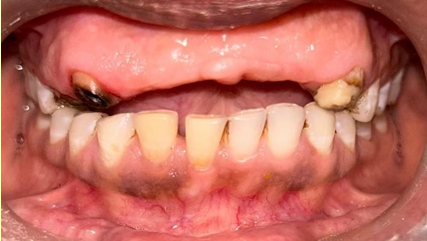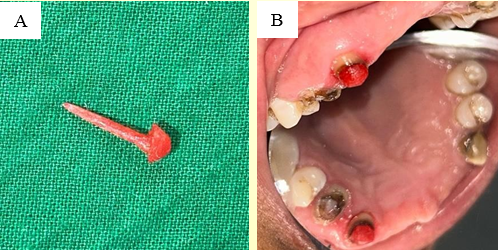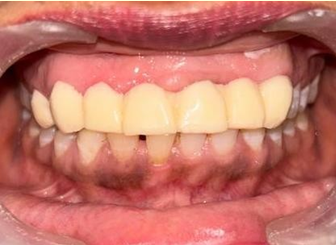- Visibility 251 Views
- Downloads 37 Downloads
- DOI 10.18231/j.ijohd.2024.011
-
CrossMark
- Citation
A case report on the rehabilitation anterior teeth using custom made post and pre fabricated fiber post and core
- Author Details:
-
Ispita Roy
-
Faujia Tarannum *
-
Shjanolima Hazarika
-
Asra Ahmed
-
Ankita Tiwari
Introduction
In cases where the remaining coronal tooth structure lacks adequate retention and resistance form for the restoration, it is often necessary to reconstruct teeth that have undergone endodontic treatment before proceeding with the final restoration. [1] Root canal-treated teeth are often challenging to restore due to fractures, dental cavities, and prior restorations and endodontic procedures.
Today, there are various post-rehabilitation methods and resources available for cases with minimal remaining coronal tooth structure. Selecting the most suitable post and core system can be challenging, leading to the use of multiple methods and materials in clinical practice for this purpose. [2] In recent years, there has been an increasing emphasis on the esthetic performance and ease of application of different post and core systems. Nevertheless, the durability and reliability of a system remain paramount. [3] There is now a range of post methods and materials designed to secure final restorations in place and rehabilitate root canal-treated teeth with moderate to severe loss of coronal tooth structure. [4], [5] When additional retention is needed to secure the core and coronal restoration, a supplemental post is inserted into the root of a tooth with insufficient structural support. [6] The primary objective of the post and core is to restore an adequate amount of coronal tooth structure to ensure proper retention, resistance, and restoration of the tooth's function and appearance. [7] Metal posts are the most commonly used type to secure the core in position. Unlike other pre-fabricated systems, cast posts and cores do not require an additional retention mechanism, such as pins, to maintain the core in place. [8] A post-core restoration is advised for a tooth that has experienced considerable crown loss, is prone to cervical area fractures, shows noticeable discoloration, has lost two proximal surfaces, has reduced height, exhibits poor retention form, and maintains good periodontal and periapical health. [9]
Two factors that influence the choice between a cast post and a prefabricated post are the canal's geometry and the amount of remaining tooth structure. [10] It has been argued that for a canal requiring extensive preparation, a well-fitted cast post and core offer greater retention compared to a prefabricated post that does not align with the canal pattern. [11], [12] The custom-made cast post and core, engineered to endure torsional forces, are placed into the prepared root canal space. The subsequent case report details the restoration of severely worn anterior teeth using custom-made cast post and porcelain-fused-to-metal crowns in the anterior esthetic zone.
Case Presentation
A 42-year-old female patient reported to the Department of Prosthodontics and Crown & Bridge, Career Institute of Dental Sciences and Hospital, Lucknow with the chief complaint of poor aesthetics due to few missing and grossly decade anterior teeth. Patient desired to get them restored. On clinical examination it was revealed that 11, 21, 12, 22 was missing and 13, 43, 23 was decayed as shown in ([Figure 1] ).

Clinical pre-operative photograph revealed root canal treated teeth with #13, #14 and #23.
Radiographic evaluation revealed that the anterior teeth had undergone endodontic treatment. No indications of periapical infection or periodontal widening were observed. Consequently, our objective was to restore the lost tooth structure's form and function. The treatment paln for the involved teeth teeth included a custom-made cast post and core for 13 and fiber post for 14 and 23 followed by full coverage porcelain fused metal crowns with #14, #13, #12, #11, #21, #22 and #23.
Clinical steps
Secondary caries were removed, and post space preparation was conducted on teeth 13, 14 and 23 using a peezo-reamer ranging from #1 to #4 (MANI Inc., Japan) and an endodontic hand instrument to accommodate the post. The canal was prepared to retain 4 mm of gutta-percha for maintaining the periapical seal. Subsequently, the apical seal and post-space preparation were assessed.
Metallic posts were fabricated using an indirect technique. A separating media was applied to the prepared post space, and an impression of teeth 13 was made using pattern resin (GC America, Pattern resin) ([Figure 2]).

The fabricated cast metal post for 13 was cemented using zinc-phosphate cement (Prevest Denpro, USA) and post space created for 14 and 23 was restored using fiber post and core build- up was done using composite. Subsequently, the teeth were prepared with a circumferential chamfer, which included 1.5 mm of ferrule preparation ([Figure 3]).

Silicone impression material was used to take impressions and master cast poured. Metal framework fabricated followed by try-in of metal framework ([Figure 4]).

Shade selection was done. Porcelain-fused-to-metal crowns were fabricated then cemented using luting glass ionomer cement ([Figure 5])

The treatment outcome met the patient's expectations ([Figure 6]).

Discussion
Custom cast post fabrication is favored for restoring both esthetics and function, providing optimal retention and resistance. In cases of mutilated teeth, post and core restoration is considered a fundamental procedure. Cruegers et al. (2005) investigated the success rates of cast and metal posts over 60 months, evaluating the long-term success of metal posts in subsequent follow-ups. [11] Ellner et al. conducted a 109-month follow-up study in 2003, comparing the success rates of cast and metal dowels and finding them to be similar in both cases. [8] The main objective of this procedure is to sustain the core restoration, which replaces lost coronal structure, by providing retention. Alternatives include prefabricated composite posts or one-piece customized posts and cores. [5] To facilitate the eventual restoration of the tooth with an indirect extra-coronal restoration, a post-and-core restoration is typically used to restore the majority of the severely damaged coronal portion of the tooth. [13]
This case report considered custom cast posts and cores to be state-of-the-art for restoring teeth with prior endodontic treatment. However, prefabricated posts are now commonly preferred over custom cast posts and cores. Cast posts and cores offer advantages such as enhanced flexibility within the root canal and preservation of more tooth structure. Because the core is integral to the post, there's no need for the post to retain it, and they also provide anti-rotational properties.
Nevertheless, they necessitate multiple visits, which is a drawback. [14] The use of custom cast posts for root canal and crown preparation offers advantages such as increased strength and minimal loss of tooth structure. The strength of a tooth is closely tied to the amount of remaining tooth structure. Thus, preserving the maximum amount of tooth structure is essential for the success of post and core restoration. [13], [15] The use of custom cast posts for root canal and crown preparation offers advantages such as increased strength and minimal loss of tooth structure. The strength of a tooth is closely tied to the amount of remaining tooth structure. Thus, preserving the maximum amount of tooth structure is essential for the success of post and core restoration. [3]
Prefabricated posts are available in various materials such as metal (stainless steel, titanium), fiber (carbon, glass), and ceramic (Zirconia). These posts may have different surface characteristics, including circular cross-sections (serrated, smooth, threaded, and roughened). Both parallel and tapered post shapes are available, along with corresponding drills for creating post gaps. [15]
Conclusion
When selecting the optimal post and core systems, factors such as the quantity and quality of preserved tooth structure, aesthetic needs, as well as their indications, advantages, and disadvantages, must all be considered. Extensive research has been conducted comparing the effectiveness and applications of different types of posts and the materials used to manufacture them. While further studies are needed to validate the method outlined in the case report, it is straightforward, efficient, and offers a potential alternative for salvaging severely damaged or decayed teeth. The creation of a custom post and core has yielded positive results.
Source of Funding
None.
Conflict of Interest
None.
References
- D Saini, V Legha. Esthetic rehabilitation of mutilated anterior teeth with custom cast post and core porcelain- fused-to-metal crowns. Int J Experiment Dent Sci 2015. [Google Scholar]
- A Torbjörner, B Fransson. A literature review on the prosthetic treatment of structurally compromised teeth. Int J Prosthodont 2004. [Google Scholar]
- R Mcandrew. . Contemporary Fixed Prosthodontics, 3rd Edn. . [Google Scholar]
- CJ Goodacre, KJ Spolnik. Quintessence books; 1994. The prosthodontic management of endodontically treated teeth: a literature review. Part I. Success and failure data, treatment concepts. J Prosthodont 1994. [Google Scholar]
- NP Shah, AM Gaikwad, SM Ram, JB Nadgere. Masking conventional metallic cast post for enhancing esthetics. J Contemp Dent 2016. [Google Scholar]
- AG Gegauff. Effect of crown lengthening and ferrule placement on static load failure of cemented cast post- cores and crowns. Gegauff AG. J Prosthet Dent 2000. [Google Scholar]
- K Singh, N Kumar, N Choudhary, N Gupta. Unconventional prosthodontics for the aesthetic rehabilitation of discoloured rotated maxillary central incisor. BMJ Case Rep 2013. [Google Scholar] [Crossref]
- S Ellner, T Bergendal, B Bergman. Four post-and-core combinations as abutments for fixed single crowns: a prospective up to 10- year study. Int J Prosthodont 2003. [Google Scholar]
- M Naumann, S Kiessling, R Seemann. Treatment concepts for restoration of endodontically treated teeth: a nationwide survey of dentists in Germany. J Prosthet Dent 2006. [Google Scholar]
- AS Fernandes, GS Dessai. Factors affecting the fracture resistance of post-core reconstructed teeth: a review. Int J Prosthodont 2001. [Google Scholar]
- NH Creugers, AG Mentink, WA Fokkinga, CM Kreulen. 5-year follow-up of a prospective clinical study on various types of core restorations. Int J Prosthodont 2005. [Google Scholar]
- JR Pereira, AL Valle, FK Shiratori, JS Ghizoni, MP Melo. Influence of intraradicular post and crown ferrule on the fracture strength of endodontically treated teeth. Braz Dent J 2009. [Google Scholar]
- Z Ozkurt, U Işeri, E Kazazoğlu. Zirconia ceramic post systems: a literature review and a case report. Dent Mater J 2010. [Google Scholar]
- K Bitter, AM Kielbassa. Post-endodontic restorations with adhesively luted fiber-reinforced composite post systems: a review. Am J Dent 2007. [Google Scholar]
- N Mohammadi, M A Kahnamoii, P K Yeganeh, E J Navimipour. Effect of fiber post and cusp coverage on fracture resistance of endodontically treated maxillary premolars directly restored with composite resin. J Endod 2009. [Google Scholar]
How to Cite This Article
Vancouver
Roy I, Tarannum F, Hazarika S, Ahmed A, Tiwari A. A case report on the rehabilitation anterior teeth using custom made post and pre fabricated fiber post and core [Internet]. Int J Oral Health Dent. 2024 [cited 2025 Sep 10];10(1):55-58. Available from: https://doi.org/10.18231/j.ijohd.2024.011
APA
Roy, I., Tarannum, F., Hazarika, S., Ahmed, A., Tiwari, A. (2024). A case report on the rehabilitation anterior teeth using custom made post and pre fabricated fiber post and core. Int J Oral Health Dent, 10(1), 55-58. https://doi.org/10.18231/j.ijohd.2024.011
MLA
Roy, Ispita, Tarannum, Faujia, Hazarika, Shjanolima, Ahmed, Asra, Tiwari, Ankita. "A case report on the rehabilitation anterior teeth using custom made post and pre fabricated fiber post and core." Int J Oral Health Dent, vol. 10, no. 1, 2024, pp. 55-58. https://doi.org/10.18231/j.ijohd.2024.011
Chicago
Roy, I., Tarannum, F., Hazarika, S., Ahmed, A., Tiwari, A.. "A case report on the rehabilitation anterior teeth using custom made post and pre fabricated fiber post and core." Int J Oral Health Dent 10, no. 1 (2024): 55-58. https://doi.org/10.18231/j.ijohd.2024.011
